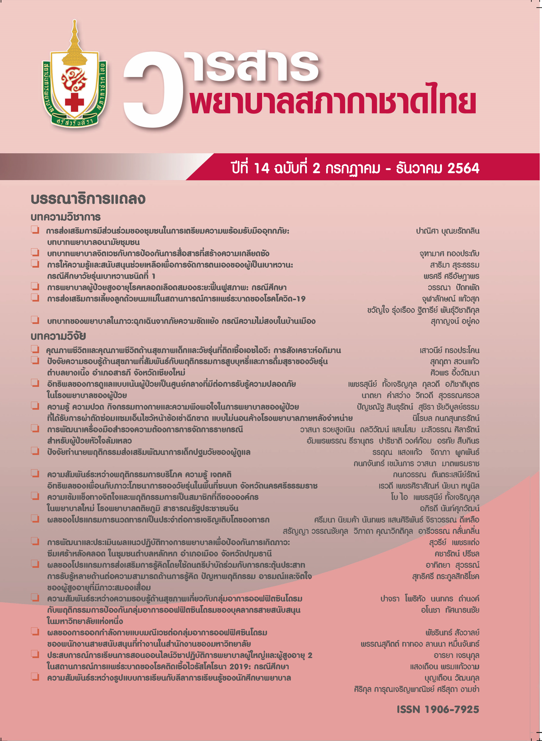The Relationship between Learning Preferences and Learning Styles in Undergraduate Nursing Students
Keywords:
learning preference, nursing student, learning styleAbstract
Determining the learning preference of nursing students is vital to effective instructional design. This descriptive correlation study was conducted to identify learning preferences and learning styles and investigate relationships between the two among undergraduate students in nursing science. Samples of 1,256 students in 2017 were recruited by each of four academic levels from Boromarajonani Nursing Colleges of Praboromratchanok Institute, Ministry of Public Health. The multiple-choice, VARK questionnaire (16-item) and the 5-point Likert scale, Grasha and Reichmann’s questionnaire (60-item), were employed to assess learning preferences and styles with online data collection. The measures had acceptable reliability coefficients of 0.85 and 0.87, respectively. Data were analyzed by descriptive statistics, Chi-square test, and Pearson’s Product Moment Statistics. The findings showed that 1) most students had a multimodal learning preference (65.8%), with participation (63.0%) being the highest, followed by collaboration (18.2%) of learning styles. 2) Learning preferences were significantly related to participation and collaboration learning styles (p < .05). 3) Reading/Writing learning preferences were significantly related to avoidance learning style (r= -0.075, p < .05). In conclusion, the findings of this study revealed the relationship between learning preferences and learning styles of nursing students, particularly participation and collaboration learning styles. Thus, in addition to improving academic performance, instructional design should include a variety of learning activities that are compatible with their participation and collaboration learning styles and learning preferences, such as the inclusion of small group discussions and seminars.
References
Fleming N. VARK: a guide to learning styles 2015 [cited 2019 Dec 25]. Available from: http://vark-learn.com/
Dewey J. Experience and education. Educ Forum 1986;50(3):241-52.
Lewin K. Field theory and experiment in social psychology: concepts and methods. Am J Sociol 1939;44(6):868-96.
Kolb AY, Kolb DA. Learning styles and learning spaces: enhancing experiential learning in higher education. Acad Manag Learn Educ 2005;4(2):193-212.
Wattanakul B, Ngamkham S, Ngamwongwan G. Differences in learning preference of nursing students. Journal of Health Science Research 2016;10(1):54-61 (in Thai)
Fleming N. Teaching and learning styles: VARK strategies. New Zealand: Christchurch; 2001.
Grasha A, Reichman S. Workshop handout on learning styles. Ohio: Faculty Research Center, University of Cincinanati; 1975.
Felder RM, Silverman LK. Learning and teaching styles in engineering education. Engr Education 1988;78(7):674-81.
Dunn RS, Dunn KJ, Price GE. Learning style inventory (LSI): an inventory for the identification of how individuals in grades 3 through 12 prefer to learn. Lawrence, KS: Price Systems; 1989.
Coffield F, Moseley D, Hall E, Ecclestone K. Learning styles and pedagogy in post-16 learning: a systematic and critical review. London: Learning and Skills Research Centre; 2004.
Fleming N. VARK classification of learning styles 2015 [cited 2018 Dec 25]. Available from: www.vark-learn.com
Janepanish Visudtibhan P, Disorntatiwat P. Learning style preferences of nursing students at Ramathibodi School of Nursing, Faculty of Medicine, Ramathibodi Hospital, Mahidol University. Nursing Journal of the Ministry of Public Health 2015;25(1):70-82. (in Thai)
Fleming N, Baume D. Learning styles again: VARKing up the right tree! Educational Developments 2006;7(4):4-7.
Grasha AF, Yangarber-Hicks N. Integrating teaching styles and learning styles with instructional technology. Coll Teach 2000;48(1):2-10.
Chinapong S, Chantanakool S, Kongsoontornkitkul A. Learning styles among undergraduate physical education and sports science students, North Bangkok University. CMU Journal of Education 2018;2(2):23-33. (in Thai)
Mwangi MCW, Muchiri WA. Learning style preferences of physiotherapy students in the Kenya Medical Training College. IJRIAS 2019;4(3):61-7.
Alkhasawneh IM, Mrayyan MT, Docherty C, Alashram S, Yousef HY. Problem-based learning (PBL): Assessing students’ learning preferences using VARK. Nurs Educ Today 2008;28(5):572-9.
Breckler J, Joun D, Ngo H. Learning styles of physiology students interested in the health professions. Adv Physiol Educ 2009;33(1):30-6.
Peyman H, Sadeghifar J, Khajavikhan J, Yasemi M, Rasool M, Yaghoubi YM, et al. Using VARK approach for assessing preferred learning styles of first year medical sciences students: a survey from Iran. J Clin Diagn Res 2014;8(8):GC01-4.
Sanboonsong P. Learning styles of undergraduate nursing students of Pathumthani University. Thai Red Cross Nursing Journal 2017;10(1):154-64. (in Thai)
Downloads
Published
Issue
Section
License

This work is licensed under a Creative Commons Attribution-NonCommercial-NoDerivatives 4.0 International License.
เนื้อหาบทความหรือข้อคิดเห็นต่างๆ ในวารสารพยาบาลสภากาชาดไทยนี้ เป็นความคิดเห็นของผู้เขียนบทความ ไม่ใช่ความเห็นของกองบรรณาธิการ หรือสถาบันการพยาบาลศรีสวรินทิรา สภากาชาดไทย






